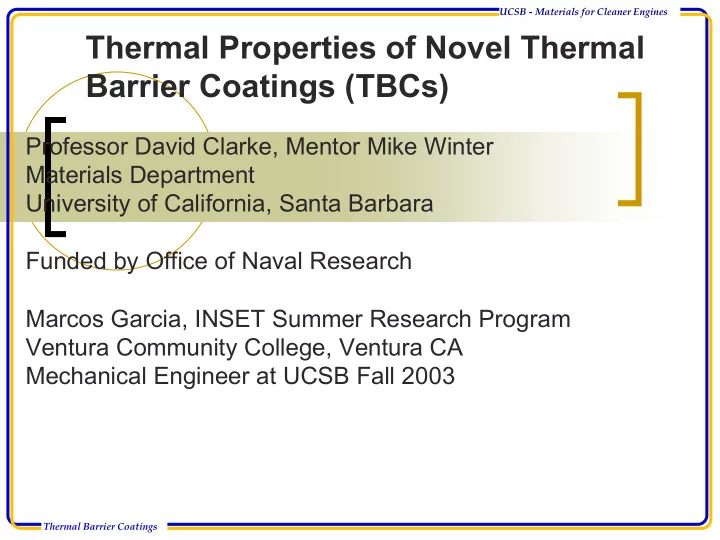

UCSB - Materials for Cleaner Engines Thermal Properties of Novel Thermal Barrier Coatings (TBCs) Professor David Clarke, Mentor Mike Winter Materials Department University of California, Santa Barbara Funded by Office of Naval Research Marcos Garcia, INSET Summer Research Program Ventura Community College, Ventura CA Mechanical Engineer at UCSB Fall 2003 Thermal Barrier Coatings
UCSB - Materials for Cleaner Engines What is a TBC? Thermal Barrier Coatings (TBCs) � Are a system of oxides grown atop a super alloy bond coat providing a protective layer. � TBCs increase the efficiency and life of the components of gas powered turbine engines. Thermal Barrier Coatings
UCSB - Materials for Cleaner Engines Why is 7YSZ unsuitable for the next generation of gas turbine engines? • The components of a gas turbine engine begin to deform at high temperatures. By selecting a coating with lower thermal conductivity, the engine can run hotter without damaging the components • The focus of the research is to select oxides with lower thermal conductivity than 7YSZ Thermal Barrier Coatings
UCSB - Materials for Cleaner Engines A look at thermal conductivity Minimal thermal conductivity can be approximated using known constants in the following expression: 2/3 m κ → ρ 2 / 3 1 / 6 1 / 2 0 . 87 k N E * min B A 2/3 M Clarke, David R. Materials selection guidelines for low thermal conductivity thermal barrier coatings. [Conference Paper] Elsevier. Surface & Coatings Technology, vol.163-164, 30 January, 2003, pp.67-74 Thermal Barrier Coatings
UCSB - Materials for Cleaner Engines Minimum thermal conductivity approximation How can thermal conductivity be minimized? Based upon the minimum thermal conductivity approximation: 1 κ is proportion al to min Mean Atomic Mass ( m / M ) By adding hafnia in with the zirconia, the effect of raising the mean atomic mass will be explored. Thermal Barrier Coatings
UCSB - Materials for Cleaner Engines Determining thermal conductivity • Flash Lamp 3000 Indium IR detector measures infrared intensity Convex lens • Device measures Sample holder diffusivity ( α ) used in thermal conductivity Convex lens equation Tungsten flash lamp Thermal Barrier Coatings
UCSB - Materials for Cleaner Engines Flashline 3000 data to solve for κ Thermal Conductivity: (100) Single Crystal YSZ at 100°C κ = α ρ C p 5.5 5 ρ = Density of sample 4.5 Voltage (V) 4 C p = Heat capacity 3.5 2 L 3 α = t 1/2 t 1 t 0 0 . 48 2.5 π 2 t 0 0.1 0.2 0.3 0.4 0.5 Time (s) 1 2 Flash Method of Determining Thermal Diffusivity, Heat Capacity, and Thermal Conductivity, WJ Parker et al. Journal of Applied Physics, Volume 32, Number 9, September 1961 Thermal Barrier Coatings
UCSB - Materials for Cleaner Engines Current project YSZr/Hf mixed at two levels 7 mole percent Y2O3 14 mole percent Y2O3 Mix Percent Hf/Zr Mix Percent Hf/Zr Composition Composition 10/90 C1 10/90 C6 20/80 C2 20/80 C7 50/50 C3 50/50 C8 80/20 C4 80/20 C9 90/10 C5 90/10 C10 Thermal Barrier Coatings
UCSB - Materials for Cleaner Engines Comparison of values YSZ vs YSZr/Hf (Composition 1) 7YSZ vs. 7YSZr/HF C1 0.8 Thermal Diffusivity (cm2/s) 0.7 0.6 7YSZ 0.5 7YSZr/Hf 0.4 C1 0.3 0.2 0.1 0 0 100 200 300 400 500 600 700 800 900 Temperature (C) Thermal Barrier Coatings
Recommend
More recommend